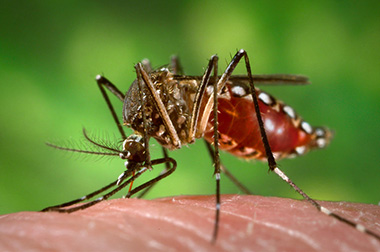Shedding New Light on Zika Transmission
 |
|
Eli Rosenberg of the School of Public Health teamed up with a CDC branch in Puerto Rico to study the sexual transmission risk of the Zika virus. Photo credit: CDC/James Gathany (Public Domain Files). |
ALBANY, N.Y. (Jan. 24, 2019) – Research by a School of Public Health professor and the Centers for Disease Control and Prevention (CDC) sheds new light on the risk of sexually transmitting the Zika virus.
The virus, transmitted primarily by Aedes species mosquitos, has existed for decades but gained notoriety during a widespread outbreak in the Americas from 2015-2017. Though the symptoms of the disease are generally mild in healthy adults, infection during pregnancy can cause severe birth defects such as microcephaly, a condition in which a baby’s brain does not develop properly.
The World Health Organization reports that to date, 86 countries have reported evidence of mosquito-transmitted Zika infection, including the United States. The vast majority of U.S. cases were in Puerto Rico, which recorded over 35,000 Zika diagnoses from 2016 to 2017. Eli Rosenberg, an associate professor of Epidemiology and Biostatistics and principal author of the new study published in the Journal of Infectious Diseases, explains that even though experts have known that Zika can be sexually transmitted, the exact level of risk was not clear.
“Until now, the majority of sexual transmission evidence has been from ‘smoking gun’ cases where a man who has traveled alone to an area with active mosquito transmission returns home and infects a partner. This provides evidence for the possibility of sexual transmission but doesn’t tell us just how important this mode is relative to other sources of risk like mosquitos.”
Rosenberg led an analysis, conducted with members of the CDC Dengue branch in Puerto Rico, to determine the risk of infection of Zika among household members in a broader study of those seeking care for Zika infection in Puerto Rico.
In this study, from May 2016 to July 2017, patients who presented with symptoms of Zika virus in Ponce, San Juan and Guayama received diagnostic testing for infection and completed a questionnaire that included demographic information, employment locations, time spent outdoors and sexual relationships. Simultaneously, up to five household members of the patient received identical diagnostic testing and questionnaires. Some 366 people in 170 households were monitored and retested periodically to assess if (and for how long) the virus was detectable in their body fluids.
The investigators mapped out the relationships between every member of the study households and used statistical methods that compared Zika risk between each pair of persons in a household. The team found that sexual partners were about twice as likely to be actively infected with Zika than non-sexual pairs. In addition to sexual contact being a risk factor, they also found that persons in homes with open or unscreened doors and windows were at increased risk for Zika infection.
Rosenberg has been working with the CDC in Puerto Rico to study the Zika virus since 2015. Updated recommendations from the CDC about the prevention of sexual transmission of Zika virus incorporate Rosenberg’s previous findings regarding the length of time Zika is detectable in semen.
Rosenberg notes that even though it may not be in the news as much anymore, Zika is still very much a public health problem.
“Zika virus is still an important public health issue,” he said. “People often forget that Zika poses a risk not only to the person infected and their offspring, but also potentially to their contacts. As such, it’s critical that we focus public health efforts not just on persons initially infected, but also on their homes and communities.”
Rosenberg’s work is among a wealth of vector-borne diseases related research undertaken by UAlbany professors, including a CDC-funded interdisciplinary $10 million initiative with the New York State Department of Health and Daniele Fabris’ National Institute of Health (NIH) funded research on the role of post-transcription RNA modification on the Zika virus gene.
![]() For more news, subscribe to UAlbany's RSS headline feeds
For more news, subscribe to UAlbany's RSS headline feeds
A comprehensive public research university, the University at Albany-SUNY offers more than 120 undergraduate majors and minors and 125 master's, doctoral and graduate certificate programs. UAlbany is a leader among all New York State colleges and universities in such diverse fields as atmospheric and environmental sciences, business, education, public health,health sciences, criminal justice, emergency preparedness, engineering and applied sciences, informatics, public administration, social welfare and sociology, taught by an extensive roster of faculty experts. It also offers expanded academic and research opportunities for students through an affiliation with Albany Law School. With a curriculum enhanced by 600 study-abroad opportunities, UAlbany launches great careers.


